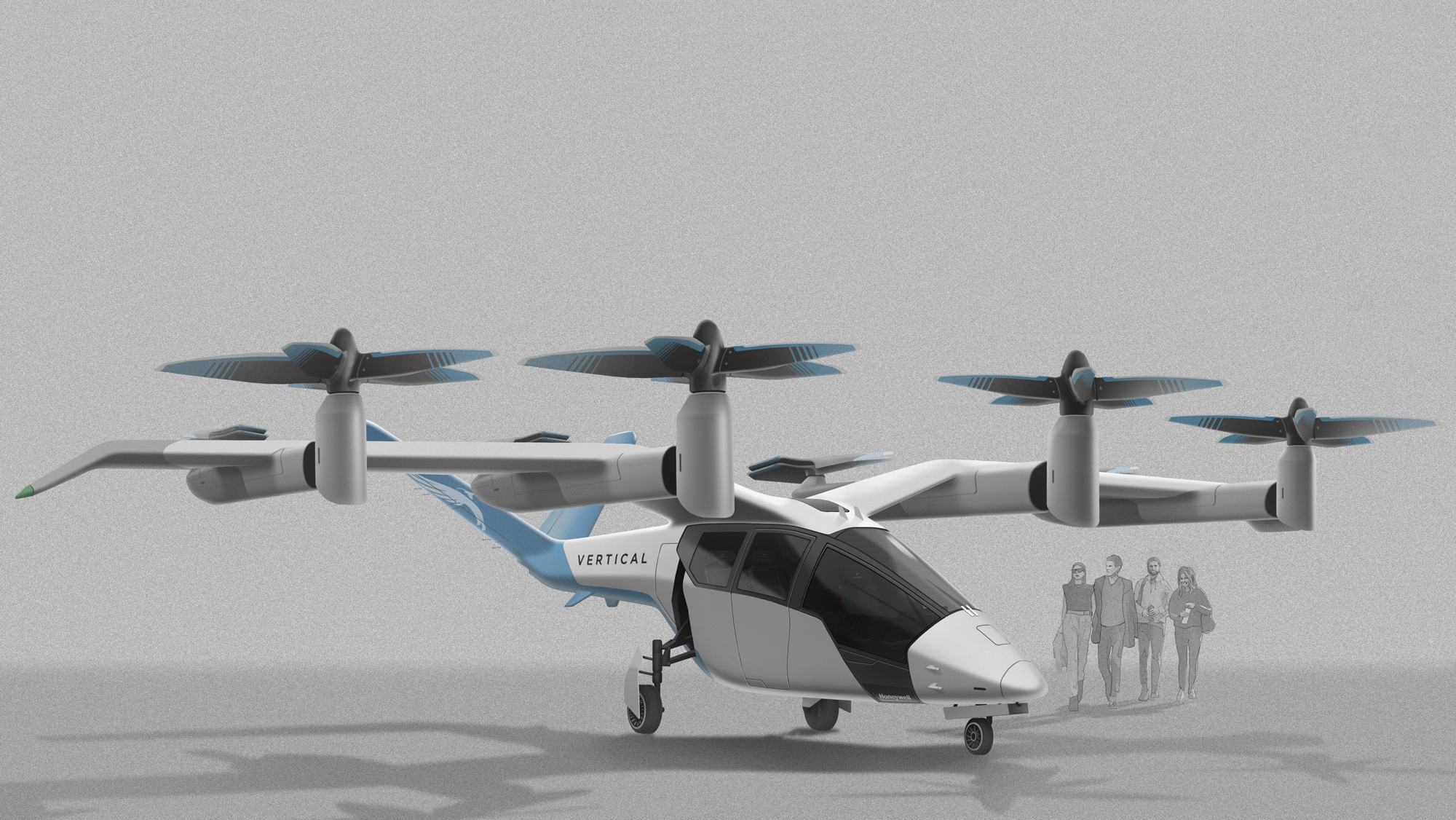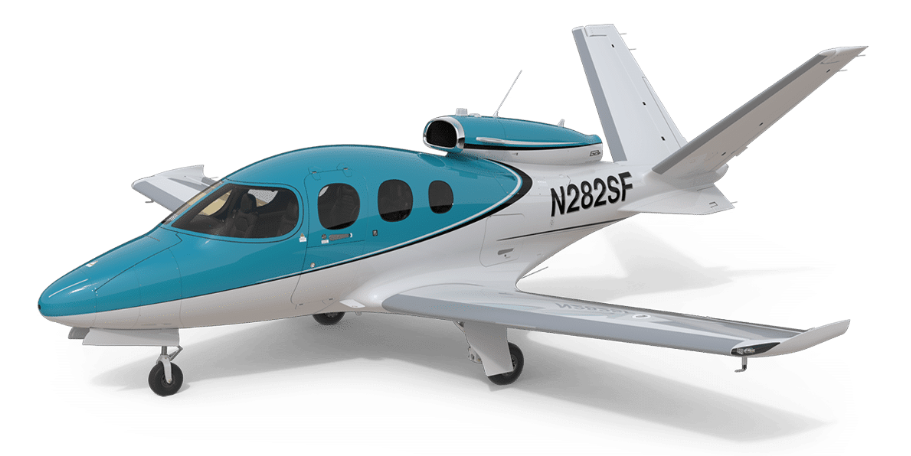Leeham News and Analysis
There's more to real news than a news release.
Bjorn’s Corner: Sustainable Air Transport. Part 50. eVTOL production volumes.
December 16, 2022, ©. Leeham News: Last week, we looked at the production costs of our typical eVTOL. We could see that it was far higher than Joby’s assumption of $1.3m for the S4, about three times higher for units above 500 and even higher for earlier units.
Let’s examine where such cost numbers come from. It’s about production ramp hockey sticks and numbers never seen before. Are these credible?

Figure 1. The Vertical Aerospace VX4 in an early rendering with similar looks to the eVTOL we discuss. Source: Vertical Aerospace.
Aeronautical production volumes
Several eVTOL startup claims they will use automotive production practices; some even claim automotive suppliers to achieve production numbers never seen before in the aeronautical industry.
Regulators like FAA, EASA, and UK CAA will teach these OEMs that the production and its supply chain all have to pass aeronautical design and production certification standards.
Automotive suppliers and their production methods/standards will not pass such certifications. It will cost any automotive supplier dearly to upgrade its production for the eVTOL OEM. The vast majority of the about half a million parts that constitute an eVTOL will come from today’s aeronautical industry.
This industry has never gone from certification, for instance, a wingbox in composites one year to producing 80 of these the following year, 300 the year after, and 600 in year three. We should pass 1,000 for year four, according to the Investor presentations of our top eVTOL OEMs. This kind of production ramp has NEVER happened for parts as complex and time-consuming to produce as aeronautical Carbon Composite primary structures.
It seems people think about an eVTOL as something small and simple. It’s NOT. The eVTOLs we talk about are larger than a Cirrus SF50 Vision jet (Figure 2) and more complex in structure and systems.
Cirrus, an experienced high-volume serial producer of PART23 aircraft with an established supply chain, had 600 orders when production started of the SF50. Its production ramp in its factory with 750 people was 2016:3, 2017: 22, 2018: 63, 2019: 81. It confirms the typical ramp in the industry of a maximum of 50% increase per year once you are beyond five per month, and 30% when you are above 20 per month. And the Vision jet is done in aluminum, a technology that is easy to ramp in production.
The eVTOL production problem
Due to the extreme mass of the 150kWh batteries needed for eVTOLs, all OEMs are pressed to minimize the mass of all components, not the least the structure. The propulsion concept with several rotors suspended on beams also forces stiff and light structural materials. It calls for the lightest structures the industry can produce. The structure material system must also be certified with its design rules and production methods between now and 2025.
The only technology that fits these criteria is thermoset CFRP (Carbon Fiber Reinforced Polymer), produced with tape prepreg or resin infusion methods. Both methods are slow and costly and might require autoclave compacting and cure to reach the porosity levels needed. To guarantee these parts’ certification and production quality in the timeframe given, the eVTOL OEMs team with established aeronautical CFRP suppliers.
There is NO WAY these can ramp, e.g., a wingbox of 45 feet from zero to 80 the first year, then 300, then 600 a year, with a wing that goes well beyond the Vision jet’s aluminum wing in dimensions and complexity, produced in thermoset CFRP.
The background to the production numbers
All eVTOL OEMs relying on outside investment have these production plans in their investor presentations. The background is simple: Their business numbers don’t close unless the number of eVTOLs flying year four after certification is in the 1000s.
On top, the projected production costs are about a third to two-thirds of what we see as plausible. And there is no capital expenditure for the $700m in excess production costs it takes to get there, on top of the billion to get certified and set up production.
When I talk to the OEMs that don’t need to pitch to investors (Airbus, Boeing/Wisk), I get a very different picture. It’s more nuanced, observes the realities of our industry and the realization that we don’t know how big the market is and how fast it will ramp.
The capital cost dilemma
Production costs will be high initially, forcing either high initial customer prices or substantial losses for the OEM on the first hundreds produced.
For the customers (operator or lessor), the amortization times for the assets will be short. There is no doubt the initial generation will quickly be replaced by a better variant. This is an emerging industry, and its technology will move fast. Thus today’s model is old tomorrow. Any organization that relays on a typical amortization plan will face scrutiny for inflated book values.
Add the resulting high capital costs to the costs for the pilot, the batteries, and high landing and underway fees, and you see a very different picture than the math of the Investor pitch decks.




There are hopes that fixed electrical engines will remove the need for movable surfaces and that most UAM’s can use the same Honeywell or similar integrated engine, communication, flight control, anti-ice and display system. So the manufacturers will make the “bubble” and bolt on standard systems of batteries, control system, motors and props. Like “Body by Fisher” and add standard GM parts in the 60’s to make a new car model. We will see if investors keep on pumping in money until we get there.
I would imagine capital outlay would be a big hinderance. Car companies are spending billions battery production. And as the article stated that is just one aspect of this.
If this does get off the ground, could we see the reemergence of commuter airlines.
Typical automotive production, AFAIK, results in a complete vehicle rolling off the line essentially ready to sell. The few minor problems are repaired by the dealership. How does that compare to aircraft production? Is there a typically a large (by % of production) pool of vehicles with extensive issues to re-work in a stall-based process off the production line?
The lauch customers of aircrafts expect problems and need to input a large number of Service bulletins and PIP packages to get close to the sales pitch performance. Hence you want launch customers with extensive MRO capabilities like Lufthansa, Japan Air Lines, Singapore Airlines, Delta Air Lines.
Agreed, but that’s a different issue. I’m referring to how undeliverable units are handled. If they back up the production line then hundreds of workers stand idle. Alternatively, a large physical area and team are required to work on post-production issues. But if everything is stall-built (aircraft production model) those issues are more easily managed.
Yes, you really need to debug the production system before pressing GO. The big danger is pressing GO too early when customers scream for deliveries and money is running out. Hence block updates with cost reductions and reliability improvements will come if run properely. Usuallay in combination with launching the next bigger model.
Pure Hopium. You’d be better off to invest in FTX…
Ford did it in WWII, cranked thousands of B-24 out of Willow Run. They were so good they supplied B-24 assemblies to other mfgs.
Piece of cake, if Ford can do it anyone can!
Now granted their V-12 Aerial engine was a no go and they cut 4 cylinder off it and used it in M4 Tanks but, lets not be picky.
This is the answer!
https://www.thedrive.com/news/the-ultimate-gmc-crackerbox-project-truck-with-a-v12-detroit-is-just-waiting-to-be-finished
Everything but the cute propeller things built in and on.
Wrong link, I got ambushed and missed the edit cutoff though the Truck is cool as well
https://www.ainonline.com/aviation-news/video/how-zero-carbon-electric-helicopter-could-save-lives-and-planet